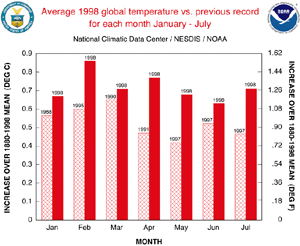 Larger Image |

Summary/Key Points...
RECORD HIGH GLOBAL TEMPERATURES CONTINUE IN JULY OF 1998
- During July we experienced the warmest global monthly surface temperatures in the instrumental record (since 1880). If these trends persist, 1998 will likely be the warmest year on record.
- Surface global land and ocean temperatures for the month of July 1998 established an all-time record high. Temperatures averaged more than 1 deg F above the 1880-1998 long-term mean. The high temperatures were particularly evident over the land as temperatures averaged nearly one and three quarters of a degree above the long-term mean, exceeding the old record by several tenths of a degree F.
- Despite the decrease in Central Pacific Ocean temperatures due to the demise of the recent El Niño and the incipient stages of a La Niña event, global ocean temperatures during July were still at record high levels, more than one-tenth of a degree F. warmer than last year at this time, when the El Niño event was rapidly building.
- July of 1998 continued the unprecedented string of record breaking temperatures. Each of the past 15 months has set new all-time record global monthly surface temperatures. July of 1998 exceeded the previous record warm July of 1997 by nearly 0.6 degree F. July 1998 will probably be the second or third warmest global monthly anomaly when final data are analyzed.
- The global land and ocean surface temperatures continue to remain at record high levels through the first half of 1998. Temperatures continue to remain far above both last year's record high levels and all other years. This year's anomaly of 1.3 deg F above the long-term mean (1880-1998) is more than 1.5 times larger than any previous year.
- For the United States, July 1998 was the 8th warmest on record based on the 1895-1998 period.

July 1998 was the warmest July on record.

The global mean temperature for July 1998 continued this year's record breaking trend with the highest temperature anomaly since reliable records began in 1880. This conclusion was based on separately examining land data using the Global Historical Climatology Network; ocean data using the National Centers for Environmental Prediction (NCEP) - Reynolds Sea Surface Temperatures (SST) blended with the NOAA Comprehensive Ocean-Atmosphere Data Set (COADS) and the United Kingdom Meteorological Office Historical SST analysis; and a global surface temperature index that combines the ocean and land data. The final anomaly may change due to inclusion of new areas of the world not currently represented. Each of the anomaly time series is based on its respective 1880-1998 mean.
Though the recent El Niño has ended, El Niño's
higher than average Sea Surface Temperatures over a large area of
the tropical eastern Pacific Ocean during the past year put extra
warmth into the global climate system, which likely contributed to
the recent global record high temperatures.
 SSMI Derived Temperature Anomalies July 1998 |
For more information, refer to ...
SSMI
Derived Products
Global Historical
Climatology Network (GHCN)
...the land data
anomalies...
...the ocean data
anomalies...
...the land and ocean data
combined into an anomaly index ...
...all in degrees C with respect to long-term (1880-1998) mean.
The period January - July 1998 was the warmest Jan-Jul of the century.

The period January-July 1998 was the warmest since reliable
records began in 1880, according to the National Climatic Data
Center. This conclusion was based on separately examining land data
using the Global Historical Climatology Network; ocean data using
the National Centers for Environmental Prediction (NCEP) - Reynolds
Sea Surface Temperatures (SST) blended with the NOAA Comprehensive
Ocean-Atmosphere Data Set (COADS) and the United Kingdom
Meteorological Office Historical SST analysis; and a global surface
temperature index that combines the ocean and land data. The final
anomaly may change due to inclusion of new areas of the world not
currently represented. Each of the anomaly time series is based on
its respective 1880-1998 mean.
 SSMI Derived Temperature Anomalies Jan-July 1998 |
For more information, refer to ...
SSMI
Derived Products
Global Historical
Climatology Network (GHCN)
...the land data
anomalies...
...the ocean data
anomalies...
...the land and ocean data
combined into an anomaly index ...
...all in degrees C with respect to long-term (1880-1998) mean.
Each month from January through July 1998 has broken the previous record.
During the past few decades, global temperatures have
persistently broken previous record highs every few years, but
never to the extent observed in 1998. Each month this year, from
January through July, has set a new all-time record high global
temperature. This is unprecedented and is not likely to occur in a
stationary climate. New analyses of tree-rings, historical records,
and other proxy measurements indicate that these temperatures are
warmer than the planet has experienced for the last 600 years
(Michael Mann, University of Massachusetts, Amherst; the work was
presented in the journal "Nature" in April 1998).
See Also...
...the recent and past anomalies
Recent Climate Extremes including Global Climate Perspectives Report for July
1998 vs. Previous Record for each month January - May
Thematic Map of Global Temperature Anomalies for January-May
Top 10 El Niño Events of the 20th Century
January-May: Record-breaking Warmth Continues
April Anomaly Doubles previous record warm anomaly globally
January-March warmest on record globally; Wetter but cooler-than-normal in US.
Warmest February on record globally
January and February, 1998, warmest and wettest on record in US
1997-98 Warmest Winter on record globally
1997 Warmest Year of the Century
As data are being received, scientists at The National Oceanic and Atmospheric Administration's National Climatic Data Center are automatically updating the Global Historical Climatology Network data base to maintain a global climate perspective in near real-time.
 NOAA's National Centers for Environmental Information
NOAA's National Centers for Environmental Information
